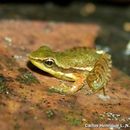Brief Summary
provided by IABIN
Diagnosis Species with toes with distinct dorsal scutes and extensive fringing on the sides of the toes; with vomerine teeth; tympanum distinct and a light lateral stripe slong the upper flank (distinct at least posteriorly.
- author
- Esteban O. Lavilla
- editor
- Diego Arrieta
Distribution
provided by IABIN
Known from Serra do Mar, in São Paulo and Rio de Janeiro State, and Ilhas Grande, Buzios e São Sebestião, Brazil.
- author
- Esteban O. Lavilla
- editor
- Diego Arrieta
Molecular Biology
provided by IABIN
Alcalóides ( Phytolaccina) nas raizes; Ácido Phytolaccino e Óleo resinoso
Diagnostic Description
provided by IABIN
Description of holotype Snout truncate from above, protruding in profile; canthus rostralis sharp; lores vertically concave in cross section; tympanum distinct, large, diameter about 2/3 diameter of eye; vomerine teeth in two small transverse patches between and on line drawn across posterior edges of choanae, separated by less than length of one vomerine tooth patch; vocal slits present, near angle of jaw on each side; vocal sacs paired, lateral, inflated; finger lengths I < II < IV < III; middle of thumb with scattered small whitish spines in small ovate area on inner and dorsal surface; dorsal texture finely etched, few scattered warts posteriorly, dorsal sufaces of legs with series of longitudinal ridges; weak fold from eye to groin; throat and belly smooth, under surfaces of thighs smooth anteriorly, areolate posteriorly; finger and toe tips with disks, disks about twice as broad as digit immediately behind disk, finger and toe disks about equal size, upper surface of disks with pair of scutes; fingers fringed, most extensively on fingers III and IV; toes extensively fringed; subarticular tubercles moderate sized, rounded; inner oval metatarsal tubercle about twice as large as pungent, rounded outer metatarsal tubercle; extensive tarsal fold-flap extending 7/8 distance of tarsus, continuous distally with toe fringe on outer side of first toe; no metatarsal fold; outer tarsus and sole of foot smooth. Snout-vent length 29.2 mm, head length 10.2 mm, head width 8.9 mm, eye-nostril distance 2.1 mm, femur 13.1 mm, tibia 14.4 mm, foot 14.5 mm. Coloration: Dorsum almost uniformly dark brown (fine bronze and gray mottle under microscope) with faint darker mid-dorsal pin stripe with small whitish dots spaced along stripe; upper limbs tan with narrow brown cross bands; flank a blending of dorsal and ventral patterns with distal l/3 of eye-groin fold whitish and distinct; continuation of dorsal color as dark canthal stripe, rest of face lighter brown and white mottle, lightest under eye and continuing under tympanum to shoulder; mid-ventral brown stripe from almost tip of chin through chest to anterior most belly; rest of throat and belly mottled brown and white; under limbs mottled with brown and pigmentless areas; posterior surfaces of thighs indistinctly mottled darker and lighter browns. Variation Males range from 2 7.5-3 1.4 mm snout-vent length, females 29.0-35.5 mm snout-vent length. Coloration in preservative, the dorsum ranges from brown to brassy brown with various markings, including an irregular mid-dorsal light stripe with almost regularly spaced small darker brown (than dorsum) spots, or a series of short dark mid-dorsal dashes, or dorsum scattered with small dark brown spots, or series of mid-dorsal large light blotches, or big darker brown blotches on a lighter brown background, or almost uniform with a series of faint light mid-dorsal dots; pair of dark round or U-shaped spots, one on each side of anus; upper limbs distinctly to indistinctly crossbarred brown on tan; flank with dark brown (almost black) band behind eye across tympanum just to or above arm, fading to mottled brown and white, ranging to flank almost uniformly dark. Coloration in life, iris copper to yellow, darker on sides forming black band with pupil; dorsum olive to dark and light brown; light stripes cream, copper, yellow, yellow-gold, or gold; flanks dark brown; upper limbs dark and light brown with or without red cast; groin yellow or not; throat and belly opalescent, bright opalescent yellow, or yellow to golden with variable brown spotting, distinct or not; under limbs colorless to dirty greenish yellow. Larval morphology Body oval in dorsal view. slightly wider than deep; snout broadly rounded in dorsal outline; nostril nearer eye than tip of snout; distance between nares 1.2 times interorbital width: nares rounded and dorsal eyes dorsolateral. diameter almost 10% body length: opening of the sinistral spiracle directed posteriorly on the midline about 61% body length: anal tube short and dextral: tail higher than body; dorsal fin origin at body-tail juncture; dorsal and ventral tins slight. arched; tail musculature reaching the round tail tip: mouth anteroventral. width 55% body width; one row of oral papillae. broadly interrupted on the upper lip: tooth row formula 2(2)/3(1): beak strongly developed and serrated. Body and tail musculature light cream with some brown flecks: tail fins transparent.
- author
- Esteban O. Lavilla
- editor
- Diego Arrieta
Hylodes phyllodes: Brief Summary
provided by wikipedia EN
Hylodes phyllodes is a species of frog in the family Hylodidae. It is endemic to Brazil. Its natural habitats are subtropical or tropical moist lowland forest and rivers. It is threatened by habitat loss.
- license
- cc-by-sa-3.0
- copyright
- Wikipedia authors and editors

